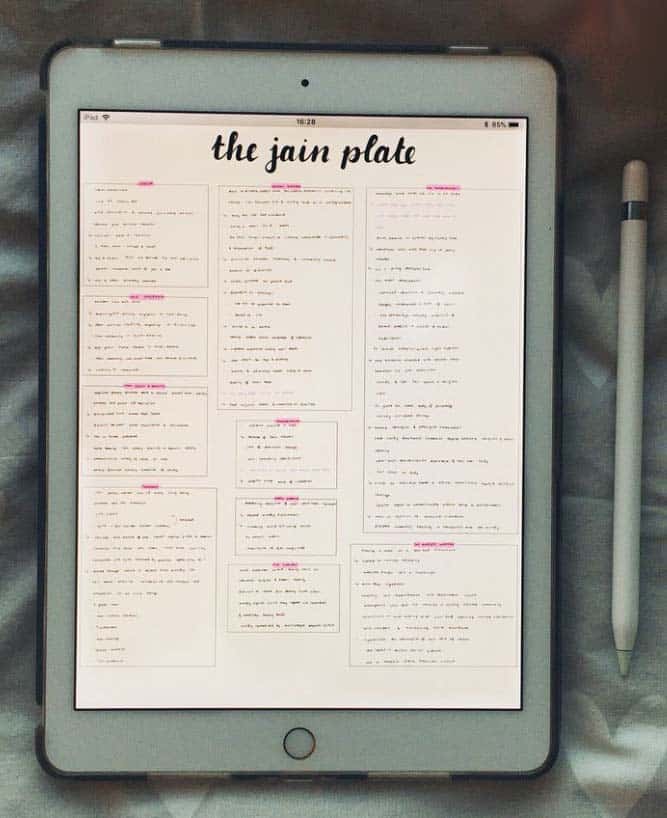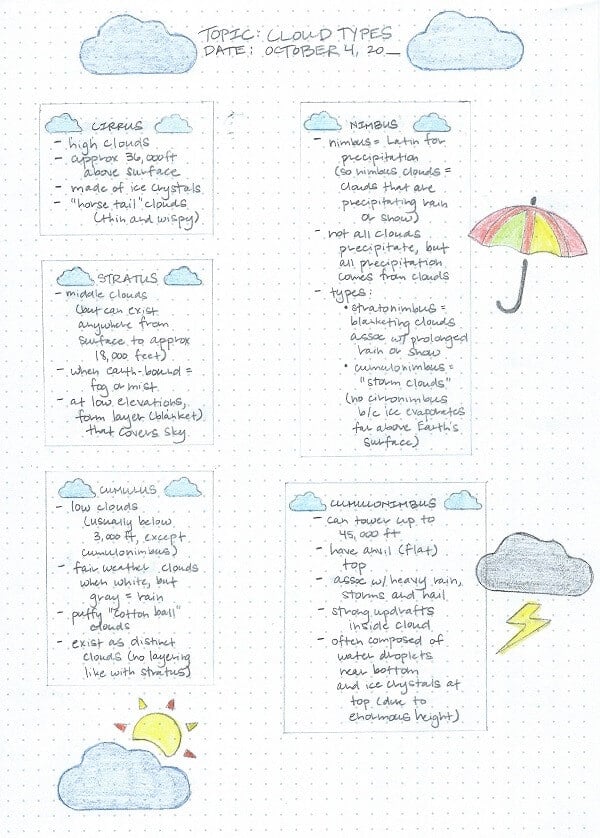- The boxing strategy takes full advantage of digital-only features such as lasso and shape insertion tools.
- Boxing notes are becoming increasingly popular among college students using iPads or touch-screen laptops.
- Notes created with the boxing style are easy to review, aesthetically beautiful, and great for visual learners.
Compared to older note-taking strategies such as the Cornell method and the outline method, the boxing method is a relatively new concept. The one thing that instantly sets it apart from other methods, such as the Cornell style, is that it was developed for digital tools from the get-go. Yet, boxing is not a technique that can be used across the board for all lectures or textbooks – you need to pick and choose when to use it.
In this guide to the boxing method of note-taking, you’ll learn the following:
The Boxing Method

What is the boxing method of note-taking?
The boxing method of note-taking uses boxes to visually separate topics from one another. Thoughts, ideas, and concepts on a particular topic are written down vertically next to each other, forming a topical cluster of information. Then, as new topics are introduced, the previous topical clusters are boxed shut, and new ones are formed.
To a certain extent, the boxing method is similar to the mapping method of note-taking, as both techniques use shapes to group topics together. While the mapping method is great for diving increasingly deeper into subtopics, the boxing method is good for smaller clusters of information that don’t have as many subcategories.
Is the boxing method only good for digital note-taking?
No, the boxing method is not limited to digital devices. While the boxing method was originally developed for tablets and laptops, it’s also very well-suited for handwritten (longhand) note-taking. After all, boxing notes in a physical notebook is essentially the same as doing so on an iPad.
If you’re using the boxing method for handwritten notes, just keep in mind that you cannot move around sentences with the lasso tool, so you’ll have to get the positioning right from the get-go. You’ll have less room for error, but the end result can be just as good, if not better, than notes taken digitally.
As proof, take a look at these handwritten notes created with the boxing method:

If you’re interested in further analysis on handwritten vs. typed notes, refer to this separate article on the topic. There, I covered the topic in much greater detail.
Advantages & disadvantages of the boxing method
All in all, the boxing method is versatile and easy to use. But, as with any other note-taking strategy, it has its advantages and disadvantages. Try to consider these pros and cons when you’re choosing a particular method of note-taking for your next class. Each method has its strong and weak points, and if you want to achieve the best results, you’ll have to be able to use a combination of different methods. Don’t rely on any single method for the duration of your student life – versatility is crucial.
These are the primary advantages of the boxing method of note-taking:
- Takes advantage of digital note-taking software capabilities,
- Boxing method notes are easy to review and revise afterwards,
- Separating topics with boxes facilitates visual learning styles,
- Boxing results in aesthetically beautiful notes,
- With boxing, you can reduce notes naturally without having to rewrite.
At the same time, the boxing method is not perfect. These are the main disadvantages of the boxing method of note-taking:
- Using the boxing method requires great concentration skills,
- Boxing is time-intensive and unsuitable for live, fast-paced lectures,
- Requires well-structured learning materials and/or lectures,
- While boxing, it’s easy to get distracted by “box aesthetics”.
How to takes notes with the boxing method
This is how you take notes with the boxing method:
Split the paper into columns and add headings
To begin, you’ll want to split the page into columns that will represent individual topics. To mark the topic of each column, add headings to the top of each column so that you know what notes you’ll be taking in each of them.
- If you’re using horizontal (portrait) pages, use two columns side-by-side
- If you’re using vertical (landscape) pages, use three to four columns side-by-side.
You don’t need to draw any lines – just keep these columns in your head and try not to cross over these imaginary lines. Or, if you prefer – you can draw vertical lines to separate the columns. However, I would advise against this as you won’t know exactly where the line should be until you write your notes.
Write your notes into the columns
For this step, start writing down any thoughts, ideas, and concepts into the appropriate columns. Whenever you get a new piece of information, summarize it and place it under the most relevant heading. Take attention to the placement of your notes – the boxing method only works if the topical clusters of information are clearly separated from one another.
To save space and time, try to use telegraphic sentences when possible. Use abbreviations, symbols, short sentences – anything to reduce the size of your notes. Boxing method notes work best when they are written in a short but information-packed manner.
Move, edit, and resize your notes (Optional)
This step is only relevant to you if you’re using the boxing method on a digital device.
One major advantage of using the method on a device such as a tablet or a touch-screen laptop is the lasso tool. All note-taking software has a lasso tool, and it allows you to select a written sentence and place it somewhere else on the page. It also allows you to resize if needed.
This seems like a very simple feature, but it’s a godsend for boxing method notes. Sooner or later, you’ll realize that one of your columns needs to be broken up or that a note needs to go into another column. Instead of having to rewrite your notes, the lasso tool will allow you to simply pick up the sentences and move them to the correct location.
Draw boxes around the topics
Now, it’s time for boxing.
This is where the column separation you did in step #1 comes in handy. As you already have each column separated topic-by-topic, all you have to do is to draw all borders for the columns, and you’ll have your boxes all set and done.
If needed, you can go back to step #3 and move, edit, and resize your notes. Often this is done because of massive size differences between the boxes. If you see that one of your boxes has 20 notes in it while another has 2, it can sometimes be a good idea to separate that large box into multiple smaller ones.
This is where the strength of the boxing method shows itself. The boxes will visually separate each topic from its neighbor and allow you to clearly distinguish between clusters of information.
Review the boxed notes
Now, the note-taking part of the boxing method is finished. All that’s left to do is to review the notes. This step is by far the most important. Without a proper review of your notes, you’ll memorize very little, if any, of the information.
What’s also important is when you review your notes. Note reviewing is best done within 24 hours of note-taking. Otherwise, the Ebbinghaus forgetting curve starts setting in, and you’ll start losing retention and memorization rapidly.
When reviewing your boxing method notes, try to cover the information topic-by-topic. After you’ve fully read a topic, cover the box with your hand and try to recite the information. Then, do the same for all the other boxes. By the time you’re done, you should have a clear mental and visual overview of all the boxed topics.
Once you’ve done this, you’re all finished with the boxing method. Great job! You’ve added another method to your note-taking toolbox that will help you reap the benefits of effective notes.


